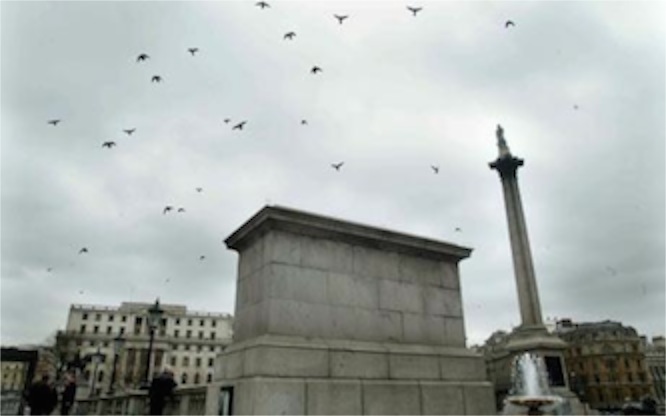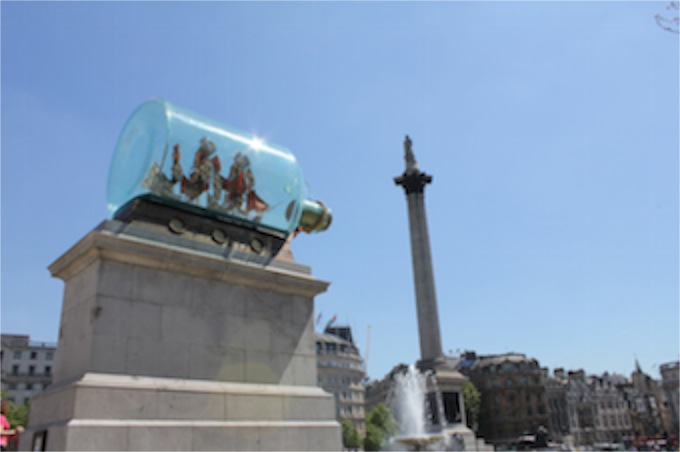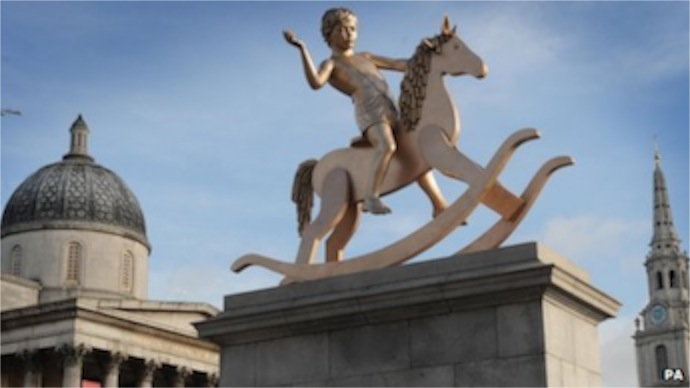The Fourth Plinth
24/02/12 05:12
When you visit London, one of the must-see areas is Trafalgar Square. I have had the opportunity to visit the space twice, once in 1978 when traveling with my family and again in 2010 when we were in England visiting our daughter. On the second trip, Trafalgar Square was the convenient meeting place for making connections with a friend from our Seminary days who now lives in England. Between our two visits, a major redevelopment of the square was completed in 2003, including the closing of a street to automobile traffic to accommodate increased pedestrian traffic, and a new set of steps leading up to a terrace in front of the National Gallery. The changes mean that one no longer has to dodge taxis to get from the square to the National Gallery. There are also new public restrooms, a café and elevators for those who have difficulty climbing the steps.

Cities need open spaces and places to gather. Our town of Rapid City is just putting the finishing touches on a new Main Street Square that has been designed to provide a similar space, scaled to the size of our city.
Trafalgar Square was a space known as Charing Cross. Plans for development of the space into a public square were begun in the 1820’s. In 1837 funds were approved for construction. The official opening of the square was in 1844, although at that time the paving and fountains were not completed until a year later.
At the center of the square is Nelson’s column, guarded by four lions – or rather four statues of lions. The designer of the square, Charles Barry was upset that the obelisk was placed in the center of his square. He wanted the works of art to be at the edges and corners of the space, leaving the center open. He did plan a pair of dramatic fountains and lots of open space.
The name itself was a matter of considerable controversy and it took a while for authorities to settle on Trafalgar Square. The name commemorates the 1805 Battle of Trafalgar when the British navy defeated the French during the Napoleonic Wars. The name narrowly defeated “King William the Fourth’s Square,” the moniker said to be preferred by the royal family. Technically the royal family owns the square, while the Westminster City Council owns the roads, including the pedestrian area that is now the North terrace.
 There are four plinths designed to hold major sculptures at the corners of the square. The original design by Charles Barry called for two monumental statues. A bronze equestrian statue of George IV tops the first. The statue, originally slated for the Marble Arch, was installed in time for the dedication in 1844. The second remained empty. It was rumored that the Lord Mayor of London wanted the plinth left empty so that it could one day accommodate a statue of him. The plinth was still bare when we visited in 1978. Two other plinths with statues were added. One is topped by a statue of General Sir Charles James Napier and was added in 1855. The other displays a statue of Major-Geneeral Sir Henry Havelock. Though constructed as one of the first two plinths, the empty one has been called the fourth plinth for a long time. In 1998, the city began to display a series of specially commissioned artworks atop the fourth plinth. When we visited in November of 2010, a model of the HMS Victory in a giant glass bottle topped it.
There are four plinths designed to hold major sculptures at the corners of the square. The original design by Charles Barry called for two monumental statues. A bronze equestrian statue of George IV tops the first. The statue, originally slated for the Marble Arch, was installed in time for the dedication in 1844. The second remained empty. It was rumored that the Lord Mayor of London wanted the plinth left empty so that it could one day accommodate a statue of him. The plinth was still bare when we visited in 1978. Two other plinths with statues were added. One is topped by a statue of General Sir Charles James Napier and was added in 1855. The other displays a statue of Major-Geneeral Sir Henry Havelock. Though constructed as one of the first two plinths, the empty one has been called the fourth plinth for a long time. In 1998, the city began to display a series of specially commissioned artworks atop the fourth plinth. When we visited in November of 2010, a model of the HMS Victory in a giant glass bottle topped it.
 The coming of the Olympic games to London this summer has occasioned the commissioning of a new piece of art for the fourth plinth and the much-anticipated unveiling took place yesterday. My first glimpse of the new statue brought a smile to my face and nearly made me giggle. I think it is a wonderful statue for the year of the games. It is a giant statue of a small boy on a rocking horse.
The coming of the Olympic games to London this summer has occasioned the commissioning of a new piece of art for the fourth plinth and the much-anticipated unveiling took place yesterday. My first glimpse of the new statue brought a smile to my face and nearly made me giggle. I think it is a wonderful statue for the year of the games. It is a giant statue of a small boy on a rocking horse.
I don’t know if it there is anything particularly British in the humor that the statue exudes, but it is simply delightful. Surrounded by statues of military heroes, one of which is mounted on a giant horse, there is a child. In the imagination of the child there can be a great leader, or a speedy jockey, or a hero rushing to the rescue. King George the fourth will forever be the king. The boy on the rocking horse might grow up to be king, but his future is still open. There are limitless possibilities in the imagination of the child.
 The people of London do not need my opinion in order to choose their public art. Truth be told, the planners of Main Street Square here in Rapid City didn’t consult me in their choices of artwork. But, for what it is worth, I favor having something atop the empty plinth. There was a type of hopefulness to a city that left space for future artwork. But there was also a type of sadness to a city that couldn’t choose a sculpture more than a century after the base had been erected. There was a sense that the stone might erode and fall down before they got around to placing anything atop the plinth. It carried an air of poor or failed planning.
The people of London do not need my opinion in order to choose their public art. Truth be told, the planners of Main Street Square here in Rapid City didn’t consult me in their choices of artwork. But, for what it is worth, I favor having something atop the empty plinth. There was a type of hopefulness to a city that left space for future artwork. But there was also a type of sadness to a city that couldn’t choose a sculpture more than a century after the base had been erected. There was a sense that the stone might erode and fall down before they got around to placing anything atop the plinth. It carried an air of poor or failed planning.
No longer is the emptiness the focus of one’s vision when standing in the square. No longer is the jarring contrast of three bronze sculptures and one great big ship in a bottle the thing that catches your eye. Now there are four bronze statues. Still, one stands out, as has been the case since the beginning of Trafalgar Square. Monuments to the glorious past of England top three plinths. The final stands as a statement of hope about the future. It is good to remember, but it is also good to hope.
I don’t know if I will make it to England to see the sculpture in person. I have no plans to make such a big trip anytime soon. I do not know how long the new sculpture will remain displayed on the plinth. It has been touted as a project for the year of the Olympics. Perhaps there are plans to move it after the year is finished. On the other hand, the Millennium Wheel still graces the skyline of London more than a decade after it was erected to celebrate a one-year event.
Sometimes change takes more time than anticipated in London.

Cities need open spaces and places to gather. Our town of Rapid City is just putting the finishing touches on a new Main Street Square that has been designed to provide a similar space, scaled to the size of our city.
Trafalgar Square was a space known as Charing Cross. Plans for development of the space into a public square were begun in the 1820’s. In 1837 funds were approved for construction. The official opening of the square was in 1844, although at that time the paving and fountains were not completed until a year later.
At the center of the square is Nelson’s column, guarded by four lions – or rather four statues of lions. The designer of the square, Charles Barry was upset that the obelisk was placed in the center of his square. He wanted the works of art to be at the edges and corners of the space, leaving the center open. He did plan a pair of dramatic fountains and lots of open space.
The name itself was a matter of considerable controversy and it took a while for authorities to settle on Trafalgar Square. The name commemorates the 1805 Battle of Trafalgar when the British navy defeated the French during the Napoleonic Wars. The name narrowly defeated “King William the Fourth’s Square,” the moniker said to be preferred by the royal family. Technically the royal family owns the square, while the Westminster City Council owns the roads, including the pedestrian area that is now the North terrace.


I don’t know if it there is anything particularly British in the humor that the statue exudes, but it is simply delightful. Surrounded by statues of military heroes, one of which is mounted on a giant horse, there is a child. In the imagination of the child there can be a great leader, or a speedy jockey, or a hero rushing to the rescue. King George the fourth will forever be the king. The boy on the rocking horse might grow up to be king, but his future is still open. There are limitless possibilities in the imagination of the child.

No longer is the emptiness the focus of one’s vision when standing in the square. No longer is the jarring contrast of three bronze sculptures and one great big ship in a bottle the thing that catches your eye. Now there are four bronze statues. Still, one stands out, as has been the case since the beginning of Trafalgar Square. Monuments to the glorious past of England top three plinths. The final stands as a statement of hope about the future. It is good to remember, but it is also good to hope.
I don’t know if I will make it to England to see the sculpture in person. I have no plans to make such a big trip anytime soon. I do not know how long the new sculpture will remain displayed on the plinth. It has been touted as a project for the year of the Olympics. Perhaps there are plans to move it after the year is finished. On the other hand, the Millennium Wheel still graces the skyline of London more than a decade after it was erected to celebrate a one-year event.
Sometimes change takes more time than anticipated in London.